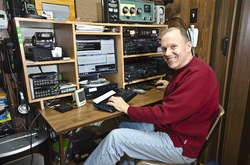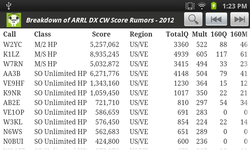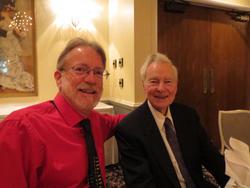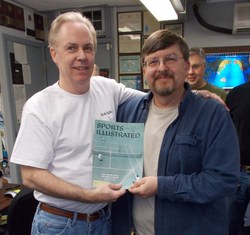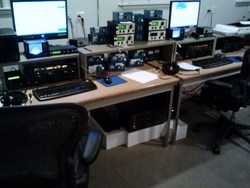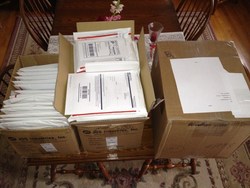 February 27, 2013 Editor: Ward Silver, NØAX | ||||||||
IN THIS ISSUE
NEW HF OPERATORS - THINGS TO DO Grab that microphone and head for the HF bands because there will be thousands of DX stations all trying to log stations in the U.S. and Canada this weekend in the ARRL DX Phone contest! If digital modes are more to your liking, there are three digital contests on the way and a couple of QSO parties that feature RTTY or PSK operation, too. BULLETINS There are no bulletins in this issue. BUSTED QSOS Software purveyor N3FJP's call was scrambled in the previous issue - but the web link was OK. Sorry about that, Scott! (Thanks, Dave K1ZZ) CONTEST SUMMARY Complete information for all contests follows the Conversation section Mar 2-3
Mar 9-10
The 2013 VHF Weak Signal Group Banquet will be held at the Dayton Hamvention on Friday evening, May 17th, at the Dayton Grand Hotel (Formerly the Doubletree Dayton Downtown Hotel). The guest speaker is Jeff Klein K1TEO - VHF Contester Extraordinaire. For tickets and more information contact Tony WA8RJF. Having mentioned ES5TV's 15 meter "Me-M-Me" echoes off the Moon, I also heard about other HF moonbounce successes by WØUN (15 and 10 meters) and ARRL CEO, K1ZZ (10 meters). Nice job, guys - let's see if we can make the round trip!
Tom K1KI came up with a pair of articles on cheating in chess and in ice fishing. Cheating at ice fishing? Perhaps there is some wisdom there for radiosport aficionados. The previous issue told the sad news of Harbach Electronics dropping the Peter Dahl line of transformers. This issue reports the happy news that Hammond Manufacturing will be winding Peter Dahl designs beginning in April of this year. (Thanks, Jeff W8CQ) Make it easy for prospective contesters to find you - the list of clubs on the Contesting Wiki needs updating with links to contest clubs around the world. There are listings from the U.S., Canada, and Argentina so there are many more to be added! Have your club secretary update your information or add it so that new members can join. What organizations out there are sponsoring FM Simplex contests? The Milwaukee Radio Amateurs Club, Wireless Society of South Hills, and the Wireless Society of Southern Maine all sponsor these short contests for new hams. If your club sponsors such a contest, let the editor know and we'll see about publishing a list of these contests. Looking up old call signs can be done online - the QRZ.com web site has some capabilities going back to 1983. The vanityhq.com Operation CQ project also has information and you can enter the history of your own call signs, too. (Thanks, Dave NN1N and George K5TR) Well-known Finnish amateur, DXer, and occasional contester Osmo Antero Wiio, OH2TK died on February 20th at the age of 85. An author, journalist, professor and former member of Finland's Parliament, he was probably best known for Wiio's Laws.(Thanks, Daily DX and Doug K1DG)
Dink N7WA has just released three Android OS apps (free!) for viewing the latest contest results posted on the 3830 reflector. The apps are available from Dink or you can search Google Play for ARRL DX Summary, WPX Summary, and NAQP Summary. The three apps support all modes of the contests and display the results in spreadsheet form. No more waiting for summaries to be posted! The application can be "sideloaded" on the Kindle Fire, too. The ARRL November Sweepstakes writeup authors are completing their reports - and looking for additional photos and stories about your efforts to share in the extended online write-ups. If you have good material, post the material in the ARRL Soapbox and drop a note to your editor! Jerry VE6CPP reports that a new VHF/UHF/µW Rover Group has just been started on the Yahoo Groups website. The Transatlantic Tests of 1921 are arguably the first formal competitive event in ham radio. Don't miss the upcoming March 18th webinar on this event, sponsored by the World Wide Radio Operators Foundation. For background on this interesting era in ham radio, check out the Radio Club of America's website! (Thanks, Jim K9JWV) Web Site of the Week - A recent XKCD comic hilariously described the Saturn-V rocket using only the 1000 most common words. The "Up-Goer Five" story proved to be such a hit that an on-line editor was created which restricts your writing in the same way. Chris W2PA posted his attempt to use the editor while writing about ham radio, contesting, and DXing. Your editor, of course, could not resist the temptation either and here is my description of radiosport: Our game of listening and talking around the world over the air is a lot of fun. We can play the game any time. Some games last for a few hours and some for two whole days. You can hear the world turning while you play the game as the Sun comes up and goes down. There are very many of us who like the game and when we play it is exciting to see how many people and places we can talk to. When we are strong we can talk to more people. We also have to listen well to be sure we get it right. It is not enough to just be fast, we have to know what we are doing, too. The game makes us better at using and understanding waves. By playing, we learn more about our selves and about the world we live in. You should listen some time and see if you would like to learn how to play, too! WORD TO THE WISE Let's put the "op" back in operators - Dave KM3T RoverMania Man, Bruce W9FZ, has posted a pair of pretty travelogues about his rambles with his XYL, Janice KA9VVQ, during this year's Minnesota QSO Party and the ARRL January VHF Contest. Let it snow and keep buttoned up! Not only does Valery R5GA develop useful websites (see the Operating Tip below) but takes pretty nice photos, too. This set is from his TO5X trip during which he placed #2 in the ARRL DX CW contest.
Tom AK2B discovered a really beautiful example of the art of homebrewing in this video by Lee Snook. Check out the cool multi-turn knobs on the left and right sides of the radio and the coax jumper technique, as well. Where did the name of the 3830 score reporting website come from? In the primitive age before the Internet, hams actually used ham radio to exchange contest scores after the contest! For reasons relatively obscure, the frequency eventually settled on was 3830 kHz. One person would collect the scores and then send them over whatever medium was available. You can hear a little of what it was like in this post-ARRL DX CW contest video as some of the East Coast multi-multi stations exchange band-by-band breakdowns after the ARRL DX CW contest. (Thanks, Dave KM3T) Tristan da Cunha, the lonely South Atlantic Ocean island better known to hams as ZD9, is the subject of this lovely photo from space and accompanying article from NASA's Earth Observatory. Luckily, there are English sub-titles available for this European version of "fantasy football". I think this could liven up radiosport "considerable." (Thanks, Lynn N7CFO) Our man in the ARRL Contest Branch, Sean KX9X, reports that the September VHF Contest results are now online and that certificates for the 2012 ARRL January VHF Contest have finally left the building. He is now busy getting all of the 2012 ARRL DX certificates in the mail.
How about this photo finish? After 48 hours of brass pounding the TI5W and VP2ME teams are within four QSOs and one multiplier of a two-way tie for first place in the DX Multi-Two category!
Yikes...that is just WAY too close! Log checkers, start your engines! Preliminary scores for the January CW North American QSO Party are available for viewing. Let the sponsors know if you spot any errors. In particular, if you see your score classified as a Multi-2 score when you were actually a Single-Op, Unassisted entry, you need you to re-submit your log. (Thanks, Kirk K4RO and Tree N6TR) A summary of the logs received for the December 2012 Canada Winter Contest has been posted online. (Thanks, RAC Canada Winter Contest Chairman, Sam VE5SF) Just three months after the contest, final results from the 2012 California QSO Party are now posted on the CQP website. The site includes full records and downloadable certificates. 848 logs were received with a grand total of 271,000 QSOs and 18 new records! (Thanks, John K6MM) A little research suggests that the Voyager spacecraft's transmitters output between 20 and 23 watts. As of last September the spacecraft was was a bit over 11 billion miles away, resulting in a miles-per-watt rating of between 492 and 566 million. (Thanks, Matt N3TZJ) OPERATING TIP
Reviewing one's log checking report is a good way to learn how to get better. Valery R5GA just added another - the reverse log generator. Currently based on the public logs from the 2012 CQ WW DX CW contest, you can enter any call sign - yours, someone else's, or even a busted call - and create a time-ordered list of everyone who worked that station. i.e. - a reverse log! Dan AC6LA has released AutoEZ, a new Excel application that works in conjunction with the EZNEC antenna modeling program. You can use AutoEZ to control diverse aspects of the model and then run multiple EZNEC test cases while automatically changing one or more variables between runs. AutoEZ can take full advantage of all the features new to EZNEC v. 5.0 such as virtual wires, realistic transmission lines with loss, transformers, L networks (which can be combined to form T and Pi networks), and parallel connected loads. The website includes numerous examples of how this powerful tool can be used for antenna system problems, such as designing antenna tuners, stubs, and transmission lines. As a means of demonstrating the effects of height above ground, Al AB2ZY recommends the charts and figures that accompany this article as being very useful in visualizing what happens as a dipole is raised and lowered.
If you are troubleshooting an amplifier's output circuit, turn off the power and be sure to ground the HV lines, then remove the tube and replace it with a non-inductive resistor of the same plate impedance as the tube from anode to ground. With all power still off, connect a network analyzer or antenna analyzer to the output connector. Tune up the output circuit and see if you can get a good match. If not, you have a problem in the output circuit! (Thanks, Mike G8TIC) Safety first! Here's a nifty way to put a lockout on the power cord of an appliance or tool so that no one plugs it in while you're working on it. The February 26th issue of the Make Magazine Newsletter also notes that those dessicant packets shipped with electronics and other items to keep them dry will also keep your tools dry. Save the packets and drop them in tool box or other tool holder! Steve N2IC warns of a potential problem for SO2R operators. While sending alternating CQs on 15 and 10 meters, he "Noticed that people calling in on 10 sounded choppy. Turned out to be 15 meter RF coming back into the 10 meter radio through the unprotected RX antenna port. I have had that happen on other band combinations in other contests." This tip applies whenever a receiver input port without filtering is connected to an antenna when a nearby transmitter is active. Technical Web Site of the Week - The on-line series from Electronic Design magazine, Impedance Matching - Parts 1-3, by W5LEF makes a good introduction and overview of the topic. Notes On ARRL DX CW After a few good January and February contests, I thought I'd summarize several topics of possible interest to the Contest Update readers. While conditions haven't exactly been the high-band sunspot peak spectaculars we experienced a decade ago, there have been openings all across the contest bands. This is a bit of a balancing act - enough solar flux to open 10 meters in a big way can have the opposite effect on 160 and 80 meters by raising absorption in the lower layers of the ionosphere. With decent conditions all across the MF and HF bands, the result has been record scores in many contests. There was some discussion around the K3LR post-contest dinner table about the "best" level of solar activity. The consensus was that a flux level of 120 would be best for all-band operation, solidly opening the higher bands while not having too big an opposite effect on the low bands. Good conditions also bring out the casual operators who further add to the scoring totals. In other words - things could be considerably worse and we're all making lots of contacts! Managing Skam We have now had a couple of contest seasons with the CW Skimmer spots being widely available from the worldwide spotting networks. Initially, the concern was that use of a "skimmer" would convey enormous advantages to a single-op station. For example, across a 100 kHz slice of band filled with stations CQing every 500 Hz, a skimmer could theoretically identify every station in less than a minute while the best human operator would take dozens of times longer to do the same thing. Certainly, this would be an advantage to the station using the skimmer, assuming the data was not available to other stations. What we see instead is so many skimmers feeding so much data into the networks that the possible advantage from any single skimmer is simply leveled out. The data problem has turned out to be not one of scarcity but of excess! It has also been noticed that the problem of self-spotting and "cheerleading" has essentially disappeared in the "fully-skimmed" environment. Things might be different during the upcoming ARRL DX Phone contest. (Statistics of the most active skimmers and most-spotted stations during ARRL DX CW were compiled by Bob, N6TV.)
Not only is there a flood of spotting information, there is also a noticeable amount of defective information in the form of bad calls - some obvious, some not - and occasionally, bad frequencies. At this stage in its development, a skimmer can be confused by signal artifacts and the timing of transmissions, causing erroneous leading and trailing letters, such as the common cases of K3LR getting spotted as EK3LR and TK3LR or W3LPL getting spotted as LW3LPL. One wonders what it must be like to actually be operating from Armenia (EK) or Corsica (TK) in competition with these spots! To me, this seems very similar to managing email spam, so I am calling these bad spots "skam". While the skimmer server teams, such as at the Reverse Beacon Network or RBN, are aware of this problem and are considering solutions, not every skimmer spot goes through a server. Logging software such as N1MM Logger has added the means to flag and suppress known bad calls, too. There is more to be done. Perhaps we can take a cue from the email world as to how to deal with automatically-generated unwanted data. Email service providers employ adaptive techniques called Bayesian filtering to assess the "spamicity" of a message. Email client software that runs on our own PCs can also filter email. Maybe we could do the same to assess the "skamicity" of a spot and keep it from propagating onto or within the spotting networks or onto our station band maps. There are numerous open-source spam filter packages so the possibility exists of adapting one to amateur spotting. And you phone operators out there, I hear you snickering about the CW spotting problem! The technology is out to "skim" SSB signals (security firms and agencies use it all the time) but hasn't gotten to the amateur community. Yet. Support Socks And one final note - in the Dec 5th issue I mentioned using support socks during the contest and decided to give it a try myself. I ordered a pair of Activskin A866 support tights and gave 'em a try during the ARRL DX CW contest. These are like a pair of bicycling tights but lighter and with a bit more squeeze on your legs. I have to say that I did notice the difference! Even after sitting at the radio for most of 18 hours a day, I didn't once have that "bloated leg" feeling I had experienced before. Furthermore, I felt somewhat more alert, particularly in the afternoon low-rate periods. This could be due to the blood circulating where it needed to - in my torso and head - instead of pooling in my legs and feet. I liked the results so much that I've ordered another pair as well as two pairs of A2409 support socks for my marathon editing sessions and long plane trips. Both the tights and socks are light enough that you can wear regular socks over them, too. Speaking of editing sessions, it's time to end this one. I'll see you on the bands this weekend in the ARRL DX Phone contest, OK? Have fun! 27 February through 12 March An expanded, downloadable version of QST's Contest Corral in PDF format is available. Check the sponsor's Web site for information on operating time restrictions and other instructions. HF CONTESTS ARRL Int'l Phone DX Contest--Phone, from Mar 2, 0000Z to Mar 3, 2400Z. Bands (MHz): 1.8-28. Exchange: RS and state, province, or power. Logs due: Apr 21. Rules North American RTTY Sprint--Digital, from Mar 10, 0000Z to Mar 10, 0400Z. Bands (MHz): 3.5-14. Exchange: Both call signs, serial, name, and S/P/C. Logs due: 7 days. Rules NS Weekly Sprint--CW, from Mar 1, 0200Z to Mar 1, 0300Z. Weekly on Thursday evenings local time. Bands (MHz): 1.8-14. Exchange: Serial, name, and S/P/C. Logs due: 2 days. Rules Open Ukraine RTTY Championship--Digital, from Mar 2, 2000Z to Mar 2, 2359Z. Multiple operating periods. See website. Bands (MHz): 1.8-28. Exchange: Regional abbreviation and serial. Logs due: Apr 30. Rules OK1WC Memorial Contest--Phone,CW, from Mar 4, 1600Z to Mar 4, 1659Z. First through fourth Monday of each month. See website. Bands (MHz): 3.5, 50, 144. Exchange: RS(T) and serial. Logs due: 7 days. Rules ARS Spartan Sprint--CW, from Mar 5, 0200Z to Mar 5, 0400Z. Monthly on the first Monday evening local time. Bands (MHz): 3.5-28. Exchange: RST, S/P/C, and power. Logs due: 2 days. Rules YL CW Party--CW, from Mar 5, 1900Z to Mar 5, 2100Z. Bands (MHz): 3.5. Exchange: RST, serial, if YL "YL," name. Logs due: Mar 31. Rules John Rollins Memorial DX Contest--CW, from Mar 6, 2300Z to Mar 7, 2300Z. Multiple operating periods. See website. Bands (MHz): 7,14. Frequencies (MHz): Exchange: RS, name, and S/P/C. Logs due: 4 weeks. Rules RSGB Commonwealth Contest--CW, from Mar 9, 1000Z to Mar 10, 1000Z. Bands (MHz): 3.5-28. Exchange: RST and serial (Commonwealth only). Logs due: 16 days. Rules AGCW QRP Contest--CW, from Mar 9, 1400Z to Mar 9, 2000Z. Bands (MHz): 3.5-28. Exchange: RST, serial, class, AGCW number or NM. Logs due: Mar 31. Rules QRP ARCI HF Grid Square Sprint--CW, from Mar 9, 1500Z to Mar 9, 1800Z. Bands (MHz): 3.5-28. Frequencies (MHz): QRP calling frequencies. Exchange: RST, 4-char grid square, QRP ARCI nr or power. Logs due: 14 days. Rules EA PSK63 Contest--Digital, from Mar 9, 1600Z to Mar 10, 1600Z. Bands (MHz): 3.5-28. Exchange: RST and serial or EA province. Logs due: Mar 31. Rules Idaho QSO Party--Phone,CW,Digital, from Mar 9, 1900Z to Mar 10, 1900Z. Bands (MHz): 3.5-28. Frequencies (MHz): CW 35 kHz above band edge; Phone 7.260, 14.260, 21.335, 28.470 MHz, plus 50, 144, 440 . Exchange: RS(T) and ID county or S/P/C. Logs due: 30 days. Rules Wisconsin QSO Party--Phone,CW,Digital, from Mar 10, 1800Z to Mar 11, 0100Z. Bands (MHz): 3.5-28, 50+, Frequencies (MHz): CW 3.550, 7.050, 14.050; Phone 3.890, 7.230, 14.290, 21.350, 28.400. Exchange: WI county or S/P/C. Logs due: Apr 11. Rules VHF+ CONTESTS OK1WC Memorial Contest--Phone,CW, from Mar 4, 1600Z to Mar 4, 1659Z. First through fourth Monday of each month. See website. Bands (MHz): 3.5, 50, 144. Exchange: RS(T) and serial. Logs due: 7 days. Rules Idaho QSO Party--Phone,CW,Digital, from Mar 9, 1900Z to Mar 10, 1900Z. Bands (MHz): 3.5-28. Frequencies (MHz): CW 35 kHz above band edge; Phone 7.260, 14.260, 21.335, 28.470 MHz, plus 50, 144, 440 . Exchange: RS(T) and ID county or S/P/C. Logs due: 30 days. Rules Wisconsin QSO Party--Phone,CW,Digital, from Mar 10, 1800Z to Mar 11, 0100Z. Bands (MHz): 3.5-28, 50+, Frequencies (MHz): CW 3.550, 7.050, 14.050; Phone 3.890, 7.230, 14.290, 21.350, 28.400. Exchange: WI county or S/P/C. Logs due: Apr 11. Rules LOG DUE DATES 27 February through 12 March
ARRL Information Click here to advertise in this newsletter, space subject to availability. Your One-Stop Resource for Amateur Radio News and Information ARRL membership includes QST, Amateur Radio's most popular and informative journal, delivered to your mailbox each month. Subscribe to NCJ - the National Contest Journal. Published bimonthly, features articles by top contesters, letters, hints, statistics, scores, NA Sprint and QSO Parties. Subscribe to QEX - A Forum for Communications Experimenters. Published bimonthly, features technical articles, construction projects, columns and other items of interest to radio amateurs and communications professionals. Free of charge to ARRL members: Subscribe to The ARRL Letter (weekly digest of news and information), the ARES E-Letter (monthly public service and emergency communications news), Division and Section news -- and much more! ARRL offers a wide array of products to enhance your enjoyment of Amateur Radio. Visit the site often for new publications, specials and sales. Donate to the fund of your choice -- support programs not funded by member dues! Reprint permission can be obtained by sending email to permission@arrl.org with a description of the material and the reprint publication. ACKNOWLEDGEMENTS ARRL Contest Update wishes to acknowledge information from WA7BNM's Contest Calendar and SM3CER's Contest Calendar. | ||||||||
